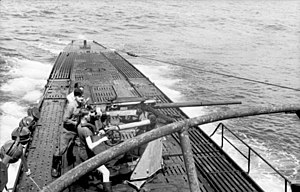 U-103 in 1939. Looking backwards from the conning tower. Note the width of casing of the Type IX compared to the Type VII U-boat
| |
| History | |
|---|---|
| Name | U-103 |
| Ordered | 24 May 1938 |
| Builder | AG Weser, Bremen |
| Yard number | 966 |
| Laid down | 6 September 1939 |
| Launched | 12 April 1940 |
| Commissioned | 5 July 1940 |
| Fate | Scuttled on 3 May 1945 at Kiel |
| General characteristics | |
| Class and type | Type IXB submarine |
| Displacement | |
| Length |
|
| Beam |
|
| Height | 9.60 m (31 ft 6 in) |
| Draught | 4.70 m (15 ft 5 in) |
| Installed power |
|
| Propulsion |
|
| Speed |
|
| Range |
|
| Test depth | 230 m (750 ft) |
| Armament |
|
| Service record[1][2] | |
| Part of: |
|
| Identification codes: | M 04 095 |
| Commanders: |
|
| Operations: |
|
| Victories: | |
German submarine U-103 was a Type IXB U-boat of Nazi Germany's Kriegsmarine that operated during World War II. She was one of the most successful boats in the entire war, sinking 238,944 gross register tons (GRT) of Allied shipping in 11 patrols, in a career lasting more than four years.
U-103 was laid down on 6 September 1939 at DeSchiMAG AG Weser in Bremen as yard number 966. She was launched on 12 April 1940 and commissioned on 5 July under the command of Korvettenkapitän Victor Schütze. After her warm-up, (designed to give her an opportunity to train and repair minor faults), she was deployed into the North Atlantic in September 1940 and saw overwhelming success, sinking 46 ships and damaging three other vessels.
- ^ Helgason, Guðmundur. "German U-boats of WWII: U-103". German U-boats of WWII – uboat.net. Retrieved 25 December 2012.
- ^ Helgason, Guðmundur. "U-boat patrols: War Patrols by U-64". German U-boats of WWII – uboat.net. Retrieved 25 December 2010.